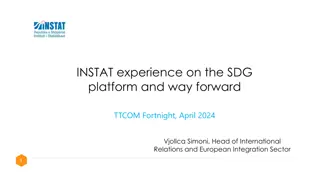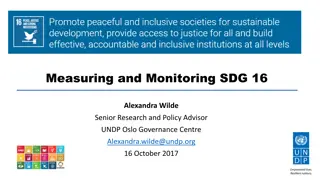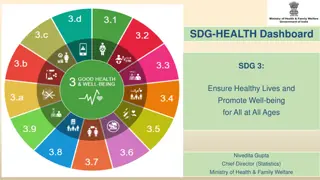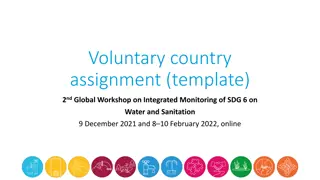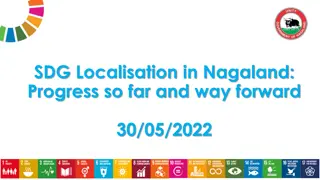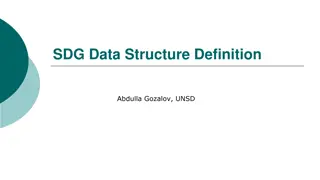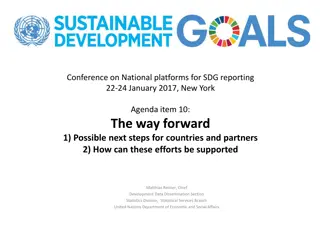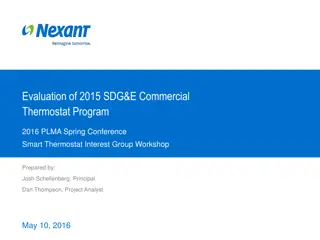Evaluation of SDG&E Summer Saver Program 2016
Detailed evaluation of the 2016 SDG&E Summer Saver program, including program overview, methodology, results, and impacts on residential and small commercial customers. The program offered demand response events to control central air conditioning load, with participants incentivized through annual bill credits. Findings show significant load reductions during events, with the largest reduction observed on July 22nd. Various methodologies were employed to assess ex-ante and ex-post impacts on different customer segments.
Download Presentation

Please find below an Image/Link to download the presentation.
The content on the website is provided AS IS for your information and personal use only. It may not be sold, licensed, or shared on other websites without obtaining consent from the author. Download presentation by click this link. If you encounter any issues during the download, it is possible that the publisher has removed the file from their server.
E N D
Presentation Transcript
2016 SDG&E Summer Saver Load Impact Evaluation DRMEC Spring 2017 Load Impacts Evaluation Workshop May 8, 2017
Agenda Summer Saver program overview Ex post methodology Ex post results Ex ante methodology Enrollment forecast Ex ante results Ex post results for subgroups 2
Program Overview Day-of demand response program offered by SDG&E to residential and small commercial customers Based on central air conditioning (CAC) load control, using direct load control (switches with 1-way paging communication) Events may be called on any non-holiday from May-October and run between 2 to 4 hours No more than three event days per week and no more than 60 event-hours per year Participants have a choice of cycling strategy: Number of Enrolled Customers Customer Type Cycling Strategy % of CACs Enrolled 50% 60% 12,733 Residential 100% 40% 8,167 30% 28% 1,047 Commercial 3,522 50% 72% Participation is incented with an annual bill credit based on cycling strategy and tonnage of enrolled CAC unit(s) Residential - $11.50 per ton for 50% cycling, $30 per ton for 100% cycling Commercial - $ 9 per ton for 30% cycling, $15 per ton for 50% cycling 3
Ex Post Methodology Nexant estimated reference loads using a randomized control trial (RCT) for the residential segment, and a matched control group for the small commercial segment Matched control group was selected using a propensity score, which calculated the likelihood that a customer is a Summer Saver participant based on: Peak demand on hot, nonevent days; and Demand in the morning and afternoon prior to an event Ex post impacts were estimated for each hour of each event by taking the difference between the same-day adjusted average control group load and the average observed treatment group load 4
Ex Post Results 5 Summer Saver events in 2016 All events occurred on weekdays from 3 PM to 7 PM Hours of Availability Hours of Actual Use # of Available Dispatches # of Actual Dispatches 60 20 15 5 Event Date Day of Week Event Times Residential impacts: Aggregate load impacts ranged from 4.1 MW to 12.9 MW across all events Average aggregate impact was 8.1 MW 6/20/2016 7/22/2016 8/15/2016 9/26/2016 9/27/2016 Monday Friday Monday Monday Tuesday 3 to 7 PM 3 to 7 PM 3 to 7 PM 3 to 7 PM 3 to 7 PM 3 to 7 PM Small Commercial impacts: Aggregate load impacts ranged from 0.4 MW to 1.7 MW across all events Average aggregate impact was 1.3 MW Average* * Reflects the average 2016 Summer Saver event Overall program: Largest load reduction of 14.6 MW on the July 22nd event across residential and small commercial 5
Ex Post Results Residential Impact Date Mean17 ( F) Per CAC Unit (kW) Per Premise (kW) 0.27 0.56 0.45 0.34 0.18 0.36 * Reflects the average 2016 Summer Saver event Aggregate (MW) 6.20 12.87 10.39 7.69 4.06 8.13 6/20/2016 7/22/2016 8/15/2016 9/26/2016 9/27/2016 Average* 0.32 0.67 0.54 0.40 0.21 0.42 82 80 80 80 84 81 Small Commercial Impact Date Mean17 ( F) Per CAC Unit (kW) Per Premise (kW) 0.16 0.16 0.13 0.10 0.04 0.12 * Reflects the average 2016 Summer Saver event Aggregate (MW) 1.72 1.66 1.38 1.08 0.45 1.26 80 79 79 81 84 81 6/20/2016 7/22/2016 8/15/2016 9/26/2016 9/27/2016 Average* 0.39 0.37 0.31 0.24 0.10 0.28 6
Ex Post Results Utility and System Peak Days SDG&E peak corresponds to the HE 18 period on the September 26th event Summer Saver was not dispatched on the CAISO peak that occurred on July 27th from 4 to 5 PM SDG&E Peak: September 26th at 5:52 PM Load Impact (MW) Event Date Hour Ending Residential Nonresidential 2.23 16 6.18 1.84 17 7.43 9/26/2016 0.81 18 8.44 -0.54 19 8.70 7
Ex Ante Methodology 2016 ex ante methodology differs from previous years evaluations and is driven by: Declining ex post impacts from 2010 to 2016 for both customer segments; Lower observed impacts later in the summer (September and October) for both customer segments; and Anticipated program changes that will significantly alter the composition of the residential Summer Saver population Ex post load impacts between 2 PM and 5 PM for all events in 2015 and 2016 were used to develop the ex ante model While prior years evaluations used a multiyear ex post impacts database starting in 2010, 2015 and 2016 impacts better reflect the current state of the Summer Saver Program 8
Enrollment Forecast Residential Forecast Month Forecast Year January February March April May June July August September October November December 2017 2018 2019 2020 2021 2022 2023 2024 2025 2026 2027 15,354 13,160 12,621 12,134 11,694 11,294 10,961 10,961 10,961 10,961 10,961 15,295 13,113 12,579 12,096 11,659 11,263 10,961 10,961 10,961 10,961 10,961 15,238 13,066 12,537 12,058 11,624 11,231 10,961 10,961 10,961 10,961 10,961 15,180 13,020 12,495 12,020 11,590 11,200 10,961 10,961 10,961 10,961 10,961 15,124 12,974 12,454 11,983 11,556 11,170 10,961 10,961 10,961 10,961 10,961 15,067 12,929 12,413 11,945 11,522 11,139 10,961 10,961 10,961 10,961 10,961 15,011 12,884 12,372 11,909 11,489 11,109 10,961 10,961 10,961 10,961 10,961 14,956 12,839 12,331 11,872 11,456 11,079 10,961 10,961 10,961 10,961 10,961 14,901 12,795 12,291 11,836 11,423 11,049 10,961 10,961 10,961 10,961 10,961 14,846 12,751 12,252 11,800 11,390 11,019 10,961 10,961 10,961 10,961 10,961 14,792 12,707 12,212 11,764 11,358 10,990 10,961 10,961 10,961 10,961 10,961 14,739 12,664 12,173 11,729 11,326 10,961 10,961 10,961 10,961 10,961 10,961 2017 Drop customers in the bottom 3 usage deciles 2018 Solar customers no longer allowed to participate in Summer Saver Enrollment forecast also assumes: 1% month-to-month decline Flat enrollment after the 2018-2022 funding cycle 9
Enrollment Forecast Small Commercial Forecast Month Forecast Year January February March April May June July August September October November December 2017 2018 2019 2020 2021 2022 2023 2024 2025 2026 2027 3,682 3,248 3,183 3,123 3,068 3,017 2,975 2,975 2,975 2,975 2,975 3,675 3,242 3,177 3,118 3,063 3,013 2,975 2,975 2,975 2,975 2,975 3,668 3,237 3,172 3,113 3,059 3,009 2,975 2,975 2,975 2,975 2,975 3,661 3,231 3,167 3,108 3,055 3,005 2,975 2,975 2,975 2,975 2,975 3,654 3,226 3,162 3,104 3,050 3,002 2,975 2,975 2,975 2,975 2,975 3,648 3,220 3,157 3,099 3,046 2,998 2,975 2,975 2,975 2,975 2,975 3,641 3,215 3,152 3,095 3,042 2,994 2,975 2,975 2,975 2,975 2,975 3,635 3,209 3,147 3,090 3,038 2,990 2,975 2,975 2,975 2,975 2,975 3,628 3,204 3,142 3,085 3,034 2,986 2,975 2,975 2,975 2,975 2,975 3,622 3,198 3,137 3,081 3,030 2,982 2,975 2,975 2,975 2,975 2,975 3,615 3,193 3,132 3,076 3,025 2,979 2,975 2,975 2,975 2,975 2,975 3,609 3,188 3,127 3,072 3,021 2,975 2,975 2,975 2,975 2,975 2,975 Enrollment forecast assumes: 1% month-to-month decline Flat enrollment after the 2018-2022 funding cycle 10
Ex Ante Methodology Residential Average 2 to 5 PM Ex Post Load Impacts and 2017 Ex Ante Predictions Residential 50% Cycling Load impacts between 2 PM and 5 PM for all events in 2015 and 2016 were regressed against the average temperature from midnight to 5 pm (mean17) ???????= ?0+ ?1 ????17d + ? The model was run separately for May-August events and September-October events The regression model parameters were used to predict load impacts under SDG&E and CAISO ex ante weather conditions for 2 PM to 5 PM Average 2 to 5 PM Ex Post Load Impacts and 2018-2027 Ex Ante Predictions Residential 50% Cycling Impacts for other hours in the RA window were based on the ratio of impacts from 2 PM to 5 PM to impacts in those hours for 2015-2016 events Above method was applied twice: once to estimate 2017 impacts and again to estimate 2018-2027 11
Ex Ante Methodology Small Commercial Average 2 to 5 PM Ex Post Load Impacts and Nonweather Sensitive Ex Ante Predictions Small Commercial 50% Cycling Impacts at the end of the summer (September and October) have been substantially smaller than impacts observed in May through August, even under similar and sometimes hotter temperatures Small commercial ex post have been observed to be much less weather sensitive compared to residential impacts Ex ante impacts are based on only the average 2 to 5 PM ex post impacts from May through August and from September through October Average 2 to 5 PM Ex Post Load Impacts and Nonweather Sensitive Ex Ante Predictions Small Commercial 30% Cycling Ex ante impacts for small commercial customers are not longer driven by weather conditions 12
Ex Ante Results SDG&E 1-in-2 August Monthly Peak Per Premise Impact (kW) Aggregate Impact (MW) Customer Type Year Enrollment 2017 0.73 14,956 10.9 Residential 2018 0.72 12,839 9.21 2027 0.71 10,961 7.75 2017 0.59 3,634 2.16 Nonresidential 2018 0.59 3,209 1.91 2027 0.59 2,975 1.79 Residential ex ante year-to-year differences are driven by: Program changes occurring in 2017 and 2018 affecting enrollment 1% month-to-month enrollment decline Separate estimations for May-August events vs. September-October events Small commercial ex ante year-to-year differences are driven only by changes to enrollment (1% month-to-month decline) and event month 13
Ex Ante Results Comparison of 2016 to 2015 SDG&E August 1-in-2 Monthly System Peak Day Evaluation Year Forecast Year Per Premise Impact (kW) Aggregate Impact (MW) Customer Type Enrollment Residential 0.73 14,956 10.9 2016 2017 Nonresidential 0.59 3,634 2.16 Residential 0.48 21,671 10.5 2015 2017 Nonresidential 0.65 4,674 3.02 Differences in estimated impacts arise because: Bottom 30% of residential users will be dropped from the program in 2017, increasing per premise impacts Residential aggregate impacts in 2016 larger relative to 2015 even though 2016 enrollment is substantially lower 2016 small commercial estimates are only based on event month and not weather (slightly lower relative to 2015) Small commercial forecasted enrollment is lower relative to 2015 enrollment 14
Contact Us Candice Potter Managing Consultant, Utility Services CPotter@nexant.com (415) 640-2955
Ex Post Results by Program Subgroups Per CAC (kW) Aggregate (MW) Cycling Option Cycling Option Date Residential 100 0.42 Commercial 50 0.19 Residential 100 4.0 Commercial 50 1.4 50 0.17 30 0.10 50 2.2 30 0.3 6/20/2016 7/22/2016 0.55 0.57 0.15 0.17 5.3 7.6 1.1 0.5 8/15/2016 0.56 0.38 0.17 0.05 5.4 5.0 1.2 0.1 9/26/2016 0.42 0.28 0.14 0.02 4.1 3.7 1.0 0.1 9/27/2016 0.27 0.11 0.03 0.06 2.6 1.5 0.3 0.2 Average* 0.44 0.29 0.14 0.08 4.2 3.9 1.0 0.2 * Reflects the average 2016 Summer Saver event 16
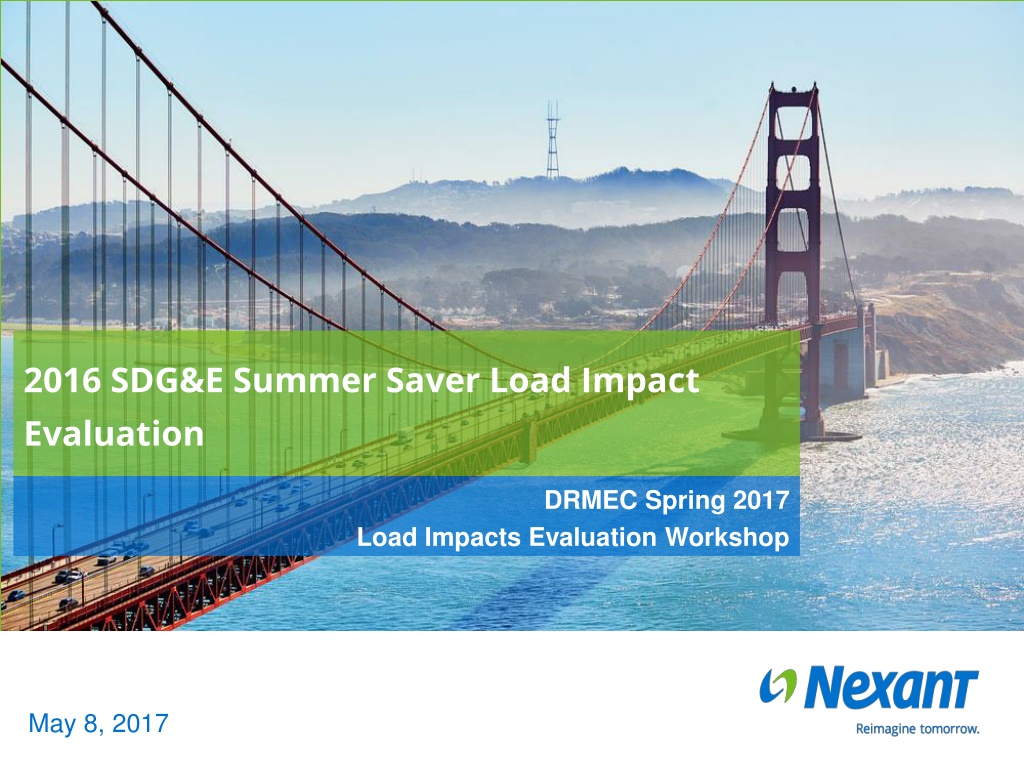
 undefined
undefined













